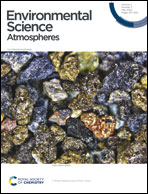Size-fractionation of trace elements in dusty snow from open pit bitumen mines and upgraders: collection, handling, preparation and analysis of samples from the Athabasca bituminous sands region of Alberta, Canada†
Abstract
A robust sample collection, handling, processing and analytical method was developed for reliable quantification of trace elements (TEs) in dusty snow. Experiments were conducted by spiking the snow and ASTM Type I water, with liquid and solid multielemental standards under both acidified (pH < 2) and unacidified conditions (pH ∼6) for a time series analysis up to one month in the metal-free ultraclean SWAMP laboratory. For the “dissolved” concentration of TEs (<0.45 μm), except for Ag, all 39 TEs investigated were precisely quantified at low levels (10 to 30 ng L−1). Regarding particulate matter (>0.45 μm), there was a significant loss by entrapment to the walls of polypropylene bottles and syringes. Employing metal-free sampling protocols, snow was collected from five bogs in the Athabasca Bituminous Sands (ABS) region, one of the largest reservoirs of bitumen in the world, to determine the impact of airborne emissions from open pit mining and upgrading. The “dissolved” fraction of bitumen enriched TEs (V, Ni, and Mo) and potentially toxic TEs (Cd, Pb, Sb, and Tl) was low. For all the TEs, including the conservative lithophiles (La and Th), total concentrations in snow and in the dust extracted from snow were greater near mining activities, whereas microscopic analyses revealed a greater size, abundance, and variability of dust particles. The enrichment factors of TEs in dust showed insignificant enrichment near industrial activities (e.g., Pb EF = 1). Furthermore, the results show that most TEs in snow near industry occur almost exclusively in the particulate fraction.

- This article is part of the themed collection: Atmospheric chemistry in cold environments - Topic Highlight


 Please wait while we load your content...
Please wait while we load your content...